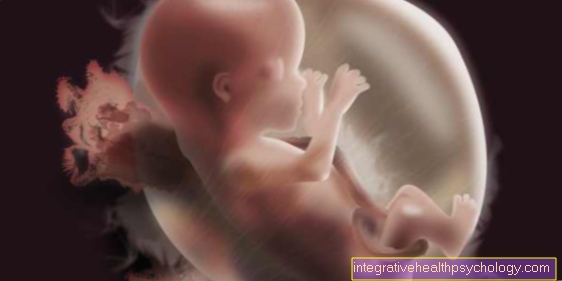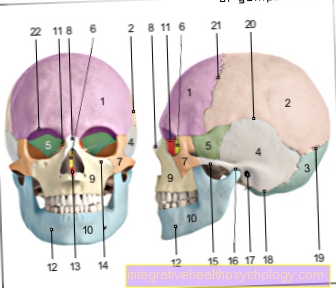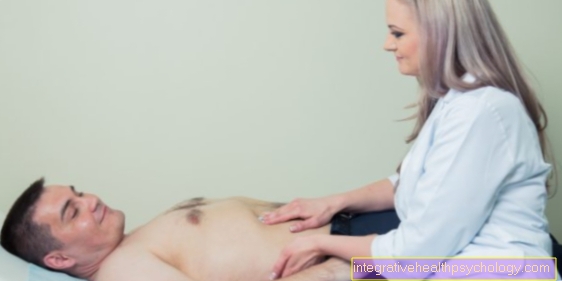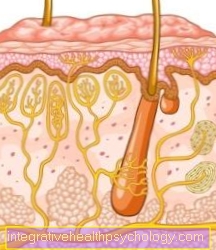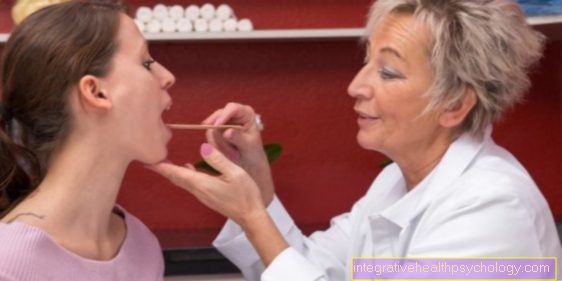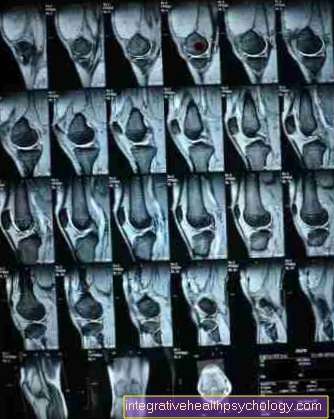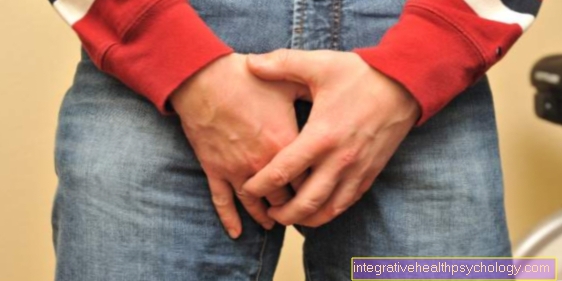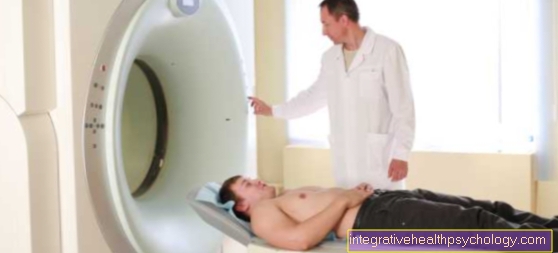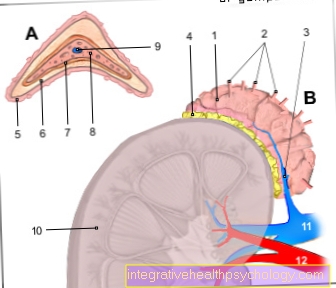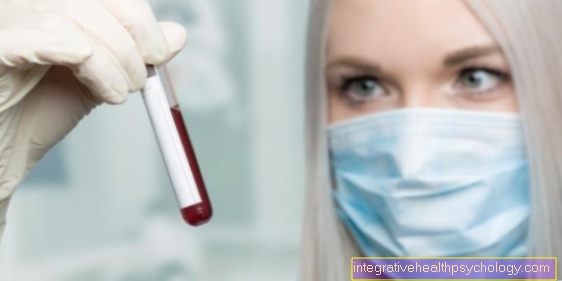Olecranon bursitis
definition
Olecranial bursitis is the inflammation of the bursa on the elbow. Colloquially, this inflammation is often referred to as the "student elbow". A distinction is made between acute and chronic bursitis olecrani, which have different causes but a similar course.

causes
Inflammation of the elbow mucous sac can have an acute or a chronic origin.
It is often caused by prolonged overloading of the elbow. This can happen, for example, by always leaning on your elbows when working regularly at your desk. This permanently irritates the elbow or the bursa lying just under the skin. Since this is particularly often the case with schoolchildren or students who have to learn, such a case is also referred to as a “student’s ellbow” or “student’s elbow”.
Acute olecranon bursitis occurs primarily through injuries: Both open injuries, for example lacerations, and closed injuries, for example bruises, can cause inflammation of the bursa. This form of bursitis often affects athletes who are at high risk of suffering elbow trauma due to the sport they practice, such as ice hockey players, volleyball players or wrestlers.
Another cause of olecranon bursitis can be metabolic diseases (e.g. gout). In addition, systemic diseases associated with dysregulation of the immune system can also cause inflammation of the bursa. These include in particular diseases from the rheumatic group such as rheumatoid arthritis.
In rare cases, bursitis can also be caused directly by pathogens that either get directly into the tissue through an injury or affect the bursa as part of an infectious disease.
Symptoms
The main symptom of olecranon bursitis is severe swelling on the elbow, which can grow to the size of a chicken egg. The other cardinal symptoms of inflammation (reddening, overheating, pain and restricted function) are also present in typical bursitis on the elbow. Because the bursa is usually filled with an effusion due to inflammation, it feels plump and elastic. In addition, so-called "grains of rice" can occasionally be discovered under the skin when touched. If the inflammation was caused by bacteria, pus can sometimes also build up.
While the symptoms of an acute olecranon bursitis appear very suddenly and severely, a chronic form can be noticed either by swelling without accompanying pain or by recurring relapses.
Please also read:
- Tennis elbow- you should know that about it
- Pain in the left forearm
Appointment with a tennis elbow specialist?

I would be happy to advise you!
Who am I?
My name is I am a specialist in orthopedics and the founder of .
Various television programs and print media report regularly about my work. On HR television you can see me every 6 weeks live on "Hallo Hessen".
As a former performance-oriented tennis player, I specialized early on in the conservative treatment of chronic tennis elbow.
In the last few years I have successfully treated several thousand tennis arms.
You can find me in:
- - your orthopedic surgeon
14
Directly to the online appointment arrangement
Unfortunately, it is currently only possible to make an appointment with private health insurers. I hope for your understanding!
Further information about myself can be found at .
therapy
Therapy for olecranon bursitis is usually started conservatively, i.e. without surgical intervention:
- The most important thing is to immobilize the elbow joint, possibly with the help of a splint, whereby it should be noted that the activity that could have caused the chronic overload of the elbow in particular should be completely stopped for a time if possible.
- In addition, cooling the affected region has a pain-relieving effect. If there is a large effusion, the bursa is often punctured to relieve pressure and thus reduce pain.
- On this occasion, there is the option of injecting anti-inflammatory drugs, such as glucocorticoids, into the bursa at the same time.
- Medicines that can be given orally and are good for relieving the pain of olecranon bursitis are nonsteroidal anti-inflammatory drugs such as ibuprofen or diclofenac.
- If the inflammation is caused by a bacterium, it may also be useful to take antibiotics.
If the conservative measures result in no or only insufficient improvement in the symptoms, an operation should be carried out. It rarely goes that far. Another indication for surgical intervention are patients in whom the bursitis is purulent.
During the operation, the entire bursa is removed (Bursectomy) and drain the pus if necessary. In the purulent form, antibiotic chains must also be placed in the wound and left there for a few days. Immediately after the procedure, the elbow should be immobilized with an upper arm splint.
Later on, elastic bandages should be used for a certain period of time. However, if the incorrect load or injuries persist, the disease may recur (Relapse) come.
Also read: Bursitis Elbow Treatment
Antibiotics
If it is a septic, i.e. bacterially infected, olecranon bursitis, antibiotics are used as therapy.
Usually the pathogen is a bacterium called Staphylococcus aureus and can be fought with certain antibiotics for 7-10 days. Even if the symptoms improve before the end of therapy, the antibiotic must be taken over time for as long as the doctor prescribed. If you stop taking it early, the bacterium can develop resistance to the antibiotic, or the inflammation can worsen again after a few days.
surgery
Some cases of olecranon bursitis can drag on for the usual period of a few weeks with pain and then months of swelling.
For example, septic inflammation, i.e. bursitis infected by bacteria that does not respond to antibiotic therapy. From the medical point of view, it is then necessary to consult an orthopedic surgeon in order to carry out surgical therapy for the bursitis. An antibiotic is usually given to support the operation, also to prevent infections caused by the operation.
Often a puncture is arranged before an operation, with which either fluid or pus can be drained. In the case of septic olecranon bursitis, the entire bursa is removed in one operation. Even in the case of non-septic but complicated courses of olecranon bursitis, the entire bursa is removed; this can possibly be done on an outpatient basis.
The skin wound usually heals within 2 weeks. After the operation, the elbow is immobilized with a splint until it can be used again after 3-4 weeks. The bursa does not grow back after the operation, but new tissue is formed which can partially replace the function. The muscles around the elbow should then be stabilized under physiotherapeutic supervision in order to counteract inflammation in the joint in the long term.
More about this at:
- Surgery for bursitis
Diagnosis
As a rule, the clinical picture of olecranon bursitis in conjunction with the medical history (anamnesis) is sufficient for diagnosis. In order to be able to assess any existing restricted mobility more precisely, the doctor often tests the range of motion in the elbow joint.
Additional examinations can be useful in order to find out the cause of the bursitis and / or not to overlook accompanying diseases. Calcium deposits can be shown in an X-ray, ultrasound or magnetic resonance tomography of the elbow can be seen and assessed, and the pathogen can be detected with a puncture of fluid. However, magnetic resonance imaging of the elbow is rarely necessary.
Various rheumatic diseases, lipoma, liposarcoma and tuberculosis are important differential diagnoses of olecranon bursitis, which should be further clarified if there is reasonable suspicion.
Duration
Inflammation of the bursa on the elbow can gradually become noticeable over a few weeks. To start therapy as early as possible, you should not wait too long to consult a doctor.
The inflammatory processes in the joint can drag on for several months. It is therefore important to start therapeutic measures early, as you can significantly influence the course of the disease. The pain disappears after a few weeks, and in most cases the swelling is still there.
Of course, the duration of olecranon bursitis also depends to a large extent on the severity of the inflammation. Another important factor influencing the course of the disease is a patient's general condition and side effects. If the bursitis was caused, for example, by rheumatoid arthritis, gout or a systemic autoimmune disease, the treatment of the underlying disease makes a significant contribution to reducing inflammation. However, if the offending disease is not treated, the duration of the bursitis will increase dramatically. Changes in work processes or reduced stress on the affected joint can also shorten the duration of the inflammation.
Further information:
- Duration of bursitis
forecast
In most cases, olecranon bursitis can be managed well with conservative measures.
It is very painful in the acute stage and can sometimes severely restrict movement in the elbow joint. However, if treatment is carried out consistently, the disease will usually heal within a few weeks without any consequences, so it is essential to avoid developing a chronic inflammation from an acute inflammation.
Should an operation become necessary, at the latest afterwards, patients can almost always count on freedom from symptoms and fully restored freedom of movement of the elbow.
prophylaxis
One Olecranon bursitis can be prevented by doing activities that involve a Injury to the elbow could cause (for example various sports), suitable Protectors wearing.
If an injury does occur, you should Wounds well cared for become. In addition, should chronic overloads of the elbow should be avoided.


